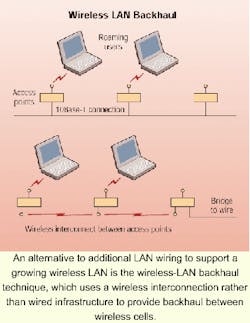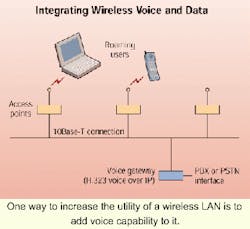Apply wireless solutions to any existing local-area-network environment.
Craig J. Mathias / Farpoint Group
Much has been written about wired-to-wireless integration, which is certainly to be expected. After all, wireless communications is often used in situations involving any scenario from the "last mile" to the "last foot" (or few feet, anyway), with the bulk of the network being implemented via traditional wire, cable, or fiber. Given all of the issues relating to wireless communications, any network designer or integrator will always do well to use wireless only where it is justified by cost (i.e., a wireless solution is cheaper than its wired counterpart, at least over the useful life of a given installation), required by physical constraints (i.e., wire simply can't be installed), or, in what is most certainly the killer application for wireless, in situations involving mobility. While wireless can serve any mission suitable to wire, the bandwidth and signal-quality advantages of wire make it preferable except when one of the above conditions is met.
An alternative to additional LAN wiring to support a growing wireless LAN is the wireless-LAN backhaul technique, which uses a wireless interconnection rather than wired infrastructure to provide backhaul between wireless cells.
Integrating wireless equipment with wired portions of a given solution is usually quite simple, since both types of equipment almost always have wired interfaces that meet industry standards. For example, the ubiquitous 8-pin modular connector used in 10Base-T Ethernet applications is present on both wired and wireless equipment, making interconnection a trivial matter in all but the most complicated situations. Other common interfaces include the RJ-11 connector used in voice applications, the RS-232 in a variety of connector configurations, and a wide range of fiber and cable connections as well.
In principle, the integration of two otherwise distinct wireless networks follows pretty much the same process. Rarely is it possible or even desirable to interface at the physical layer, using radio communications as the intermediary. Commercial wireless communications are heavily constrained in terms of available frequencies, bandwidth at those frequencies, power output, antenna configurations, and other technical factors. Moreover, wireless is subject to potential interference (particularly when using the unlicensed bands), multipath, and other propagation-related anomalies, most notably fading, which can be so severe as to preclude communications altogether. As a consequence, wireless is best applied in roles calling for one or more of the three primary considerations above, and interconnection is most often best served by wire in other cases.
Even so, situations may arise where wire is not a suitable medium for integrating two wireless facilities together. In this case there are a number of scenarios that illustrate the opportunities inherent in wireless-to-wireless integration for limited-range systems.
Wireless-LAN backhaul
Wireless local area networks (LANs) are typically implemented as a network of access points (APs) providing radio coverage to fixed (or, more often, roaming) users within radio range of the access-point network. Essentially unlimited coverage can be provided via the deployment of additional access points that usually act as wireless-to-wire bridges. The APs need to be interconnected to implement intercell handoff and provide connectivity to the remainder of the network infrastructure, including hubs, switches, routers, and servers.
One way to increase the utility of a wireless LAN is to add voice capability to it.
This interconnectivity is normally implemented via 10Base-T cables from the AP to a hub or switch. This requirement, however, begs the question: If it's a wireless LAN, how come additional wire is required? The same argument could be applied, of course, to the need for power for the AP. At least two wireless LAN vendors are now providing power via the 10Base-T cable itself, using otherwise unused wire pairs. But in the more common case where power is available but installing additional 10Base-T cable would be difficult, cost- prohibitive, or even impossible, a hybrid wireless solution is available: Simply use a wireless interconnection to provide backhaul between the cells.
There are, in fact, several ways to implement such a solution. The first would be to share backhaul traffic with user traffic on the same radio channel. This is gener ally not done because of the potentially severe performance impacts. A second technique would be to use a separate wireless LAN system, in effect doubling the number of APs required. Care also needs to be taken to use a distinct radio channel (in the case of direct-sequence-based systems) or a radio operating in a different radio band. Lucent's WavePoint-II access point actually has two PC card (PCMCIA) slots with just such a solution in mind: You use two different radios, devoting one to backhaul and one to user traffic. The need for 10Base-T interconnection is thus eliminated. This technique is also useful when installing an isolated AP, such as one installed outdoors in a weatherproof housing to provide coverage in a courtyard or similar setting.
Integrating wireless voice with a wireless LAN
Some wireless LANs can serve more than just a data-networking mission. We are seeing an increasing emphasis on multimission wireless LANs, partially to better amortize the investment made in the AP infrastructure. An obvious application is voice: Microcellular voice systems have been available for some time from private branch exchange (PBX) and other vendors, but they require their own AP network.
Wireless LAN segments can be linked by a wireless bridge, provided that the possibility of interference is carefully dealt with.
Symbol Technologies was the first to realize that wireless voice/data integration made good economic sense, with the result being the addition of the NetVision phone (and even a premises pager) to its Spectrum/24 wireless-LAN product line. The phone uses voice over IP (VoIP) technology to integrate seamlessly with the data traffic. Voice traffic is broken out via a gateway that integrates with a PBX or ordinary telephone (POTS/PSTN) lines. This situation is actually the opposite of what happens in the first example above. In this case, we are getting better productivity out of the extant wireless infrastructure by adding more applications. While the question of performance can indeed be raised, especially since voice requires prioritizing network traffic, the low bandwidth and relatively infrequent nature of voice traffic rarely stress wireless LAN channels.
Using wireless bridges
Inbuilding wireless systems normally terminate in some form of industry-standard connector, which typically mates to wired equipment of some form. Most licensed and unlicensed bridge products, which are often used in a point-to-point configuration in office-park or similar settings, also have industry-standard interconnections that simplify integration. These bridges are used to unify wireless LANs in multiple buildings, but they are also useful for cordless-phone integration. It should be noted that point-to-multipoint or "star" configurations are also possible, with the central hub acting as a controller for edge nodes.
One area of caution to consider is potential "self-jamming" from an integrated wireless LAN/wireless bridge system. Since the two may be operating in the same frequency band, care should be taken in the placement of the directional antennas used in the wireless bridge. An option, of course, is to use a separate frequency band altogether-for example, the wireless LAN might use 2.4 GHz., and the bridge could use 5.8 GHz. Care also needs to be taken when attempting to use frequency-hopping and direct-sequence systems in close proximity to one another, as the hoppers will often overwhelm the lower-power DS systems. Licensed frequencies can also be used, but frequency coordination with other installations is often required.
It is possible to apply the above techniques far beyond the local area. Cell sites in cellular and personal-communication-services networks often use licensed (and in some cases, unlicensed) bands for cell interconnection and backhaul. Inbuilding wireless voice and data systems can interface with wireless metropolitan area networks (operating in both licensed and unlicensed bands) to solve both the last-few-feet and last-mile problem simultaneously. Wireless LANs can also seamlessly integrate with satellite-based data networks, providing what might be considered the ultimate elimination of wired infrastructure. With rapidly falling prices for wireless LANs and increasing demand for high-speed access to the Internet, we expect that such multitechnology wireless integration solutions will become increasingly common over the next few years.
Craig J. Mathias is a principal with Farpoint Group (Ashland, MA), an advisory and systems-integration firm. He can be reached at (508) 881-6467 or e-mail: [email protected].


